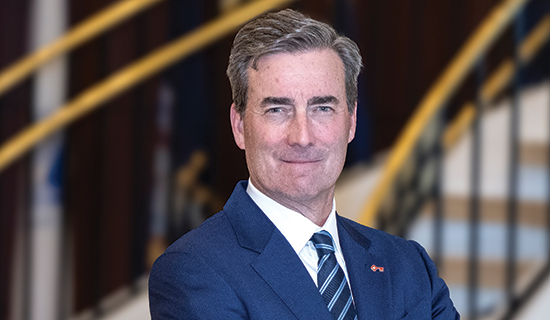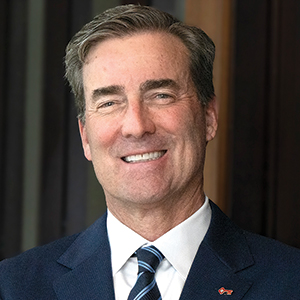Although his succession plan was put in place long before COVID-19 gripped the global economy, Chris Gorman didn’t expect his transition to the top of KeyCorp to happen during the height of the pandemic.
“Certainly, I planned for a lot of things when I knew I was going to become the chairman and CEO of Key,” he says. “But managing through a pandemic wasn’t one of them.”
Gorman joined KeyCorp through its acquisition of McDonald Investments in 1998 and has held a variety of leadership positions since then, including vice chairman and president of banking and, most recently, president and COO. Assuming the role of chairman, CEO and president on May 1, 2020, might seem like formidable timing to some, but Gorman says the Cleveland-based financial institution was prepared for the unexpected.
“It was actually kind of an exhilarating experience as everyone came together,” Gorman says. “I was so proud of how our whole team responded. We really proved to ourselves how agile we are.”
With the cultural, financial and technological foundation already laid, KeyBank smoothly transitioned to new leadership during a tumultuous time that abruptly shifted the way people work and transact. These pillars positioned the organization for record-setting growth in 2021, in terms of new clients, revenue and pre-provision net revenue, a key metric banks use to adjust for loss provisions.
By continuing to invest in teammates, technologies and targeted growth strategies, Gorman led Key through tough times to emerge stronger and better prepared for the rapid changes facing the industry. Here’s how he did it.
Modernizing services
KeyBank’s leaders started strategizing ways to digitize products and services many years ago. When Gorman took the helm as the pandemic peaked in 2020, he didn’t have to change course; he just had to accelerate the bank’s digital adoption by more than five years in a matter of months.
“We have been investing heavily in technology for many years, which frankly made our transition during the pandemic possible,” he says. “I don’t know if we’re a technology company that does banking, or a banking company that’s reliant on technology. Either way, they are inextricably linked.”
For example, KeyBank has made significant investments to modernize its core systems by adopting streamlined software solutions to replace “clunky handoffs,” Gorman says. Moving workflows into the digital realm, and ultimately onto the cloud, has improved the experience for both employees and customers by making it easier to work and transact at Key.
“As a digitally progressive bank, we’re able to work more efficiently while delivering great experiences,” he says. “One of the great things about technology is that it can free your teammates from doing rudimentary and repetitive tasks so they can spend more time thinking proactively about how to serve clients. This is one of the reasons we’re setting records in terms of revenue.”
When mandates forced banks to close, and even after branches reopened, many of KeyBank’s customers quickly turned to existing digital banking tools to handle day-to-day transactions like depositing checks, transferring funds and checking balances. The transition was frictionless, Gorman says, thanks to Key’s prior investments in technology. Now, 85 percent of KeyBank’s 3.5 million customers are digitally active.
Transitioning to remote work
Key has also made investments in technology to keep the bank running internally as employees shifted to remote work.
“No matter where people are, they have access to the information that we need to make decisions,” Gorman says.
Although many digital applications were already in place to allow easy data-sharing across the organization, which spans 15 states, Gorman and his team wanted to ensure that everyone was equipped for the evolving work environment. They stepped back to evaluate every job function to determine who needed to be in the office every day, and who needed the flexibility and digital capabilities to work remotely.
Although 7,000 of KeyBank’s 17,000 employees never stopped reporting to the office during COVID, the bank adapted with flexible options for most of its team. Today, about 20 percent of the staff work from home, 30 percent are in the office up to three days a week, and the remaining 50 percent are in the office four or five days a week.
“When we first went into the pandemic, we acknowledged that the way people work has probably changed forever,” Gorman says. “So, we took the opportunity to build out some incredible new workspaces where people can reserve a hoteling office, both at our headquarters and throughout the country.”
These flexible workspaces allow remote employees to have a productive place to work when they come into the office — which Gorman considers critical to maintaining Key’s vibrant culture.
“Technology played a big part, but what plays an even bigger part is culturally — the ability to adapt and think about what is possible instead of just thinking about how it’s been done in the past,” he says. “It’s very important in our business to have forward-looking, agile people that have an entrepreneurial spirit to serve our clients, no matter what the environment is.”
Acquiring new capabilities
Another one of Key’s growth pillars has been its approach to integrating acquisitions that expand the bank’s capabilities. Gorman joined the organization through an acquisition in 1998, and in 2016, he led the integration of First Niagara Financial Group, which increased the bank’s client base by 50 percent as the largest merger in Key’s history.
As successful as the First Niagara integration was, Gorman says the bank’s current acquisition strategy is focused more on niche financial technology (fintech) providers than on large competing depositories.
“Bringing these entrepreneurial businesses into our ecosystem helps us from a technology perspective, but it also helps us from a mindset perspective to have these innovative engineers and business leaders,” he says.
However, these fintech acquisitions can be a double-edged sword.
“From an operational risk perspective, you have to integrate these entrepreneurial businesses, but you don’t want to squash their entrepreneurial zest,” Gorman says. “Our leadership has done a particularly good job of integrating while providing the freedom to allow these businesses to do what they do best, and that’s to innovate around serving clients.”
Instead of slowing it down, the pandemic spurred KeyBank to continue its acquisition streak with the goal of expanding its digital capabilities and last year acquired analytics firm AQN Strategies LLC and digital payment provider XUP Payments — enhancing Key’s digital expertise to better serve clients with a data-driven approach.
Targeting niche sectors
KeyBank also continues to invest in strengthening previous acquisitions such as Laurel Road, a digital student loan refinancing platform purchased in 2019. Key has been bolstering the platform by hiring additional engineers and adding new capabilities specifically focused on serving health care professionals across the country, beyond the bank’s brick-and-mortar footprint. By 2021, Key turned Laurel Road into a full-service national digital affinity bank for doctors and dentists, and in 2022, added nurses to the platform.
While refinancing student loans is a big piece of the offering, Laurel Road for Doctors also gives customers access to banking services, loans and credit cards. The platform provides customers with tailored insights based on their career stage, location and medical specialty, using benchmarks to compare salaries and credit scores with other doctors in their position. Customers can also access exclusive perks and subscriptions, including discounted memberships to the American Medical Association.
As a refined fintech platform, Laurel Road is a prime example of KeyBank’s growth strategy focused on targeted scale.
“Targeted scale, in its simplest form, is knowing who you want to do business with and then building a business around them,” Gorman says. “In our case, we focus on specific client industries in high-growth niches where we can deliver unique value and generate strong returns.”
Focusing on medical professionals was an obvious target, Gorman says, as the health care industry makes up 20 percent of the U.S. gross domestic product (GDP). The technology sector, another focal point of Key’s growth strategy, accounts for another 10 percent of the GDP. Other industry targets include renewable energy and affordable housing; KeyBank ranks as the nation’s second- and third-largest lender in these spaces, respectively. Combined, these four sectors make up 20 percent of Key’s commercial revenue.
These focus areas drive Key’s acquisition strategy. These targeted acquisitions underscore Key’s commitment to creating an organization that is laser-focused on these markets.
“Frankly, it means we’re not trying to be everything to everyone, but rather, focused on where we can add value,” Gorman says. “We are identifying sectors that we are uniquely equipped to serve, and then developing the strategy, technology and people to grow those businesses.”
Investing in people
Every acquisition, technology and strategy that contributes to KeyBank’s growth “always starts with our people,” Gorman says. “Our first key to success is clearly our team.”
Across the board, KeyBank retains about 85 percent of the talent from acquired businesses. Meanwhile, the company accelerated hiring across the enterprise, increasing its bench of senior bankers by about 10 percent in 2021. To keep teammates on top of their game, KeyBank invested $12.5 million in employee growth and development in 2021, providing 580,000 hours of formal learning programs along with tuition reimbursement.
“Our bankers need to be armed with specific expertise to be most relevant to our clients,” Gorman says. “We’ll continue to invest in people, because they’re our most precious resource, and at the end of the day, banking is a people business.”
That means, despite Key’s increasing focus on digital modernization and online banking, personal interactions at its 1,000 physical branches remain an important piece of the institution’s success. The bank continues opening branches in some of the fastest-growing markets in the Western U.S., including Salt Lake City, Portland, Seattle and Denver.
“Our branches are a strength of ours, but I think the mix will continue to shift,” Gorman says. “At critical life moments, people want to sit down face-to-face with someone who can provide quality advice, whether they’re sending their kids to college, buying their first house or planning their retirement. Day-to-day transactional activity continues to migrate to digital, and that won’t stop. But for the foreseeable future, there will always be branches where you can get quality advice.”
As the future of banking rapidly becomes a current reality, Gorman and his team keep looking forward to stay ahead of changing technologies and evolving consumer preferences. By continuing to invest in digital capabilities, high-growth industries and talented teammates who can serve those niches with expertise, KeyBank is positioned for continued growth.
“We’re playing the long game, so we’re not just looking to have a lot of growth in the short term. We’re building this business to keep growing over time. To do that, you have to make sure the infrastructure is there to support your customers and your teammates,” Gorman says. “We’re going to continue to lean into growth and make investments in our people, technology and capabilities so we can serve our targeted customer base.” ●
TAKEAWAYS:
- Modernize workflows and services with streamlined software.
- Acquire new capabilities to expand your expertise.
- Focus on targeted niches where you can add value.
- Invest in people, not just technology.



